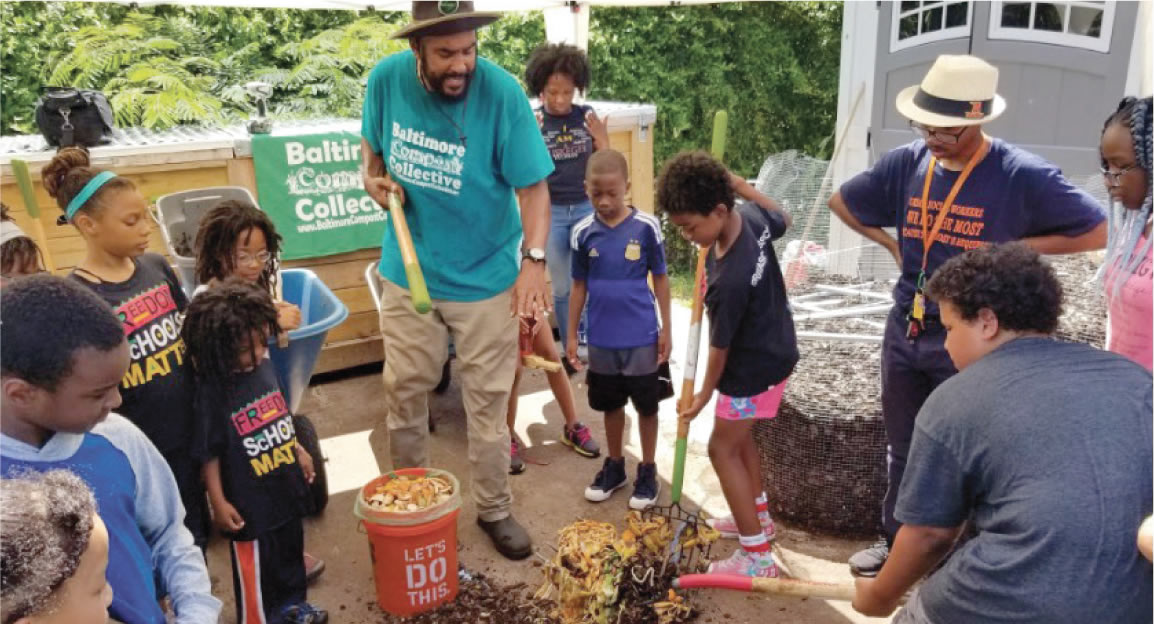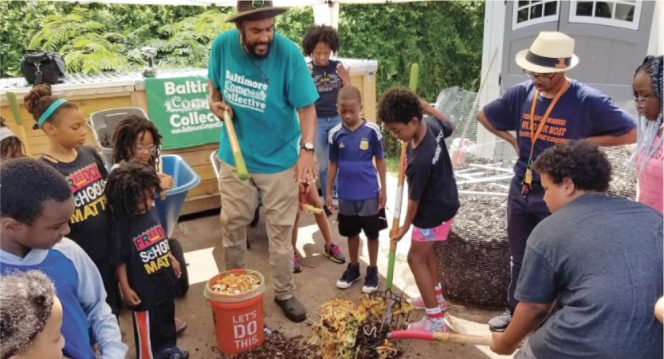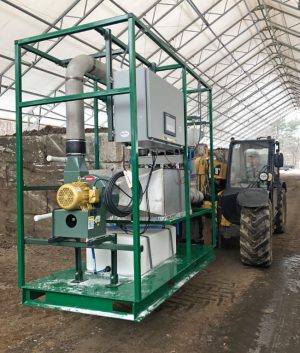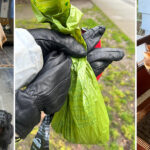BioCycle September/October 2019
Burlington, Vermont: “Resistome” Of Postconsumer Food Waste And Compost On Poultry Farm
University of Vermont researchers Korin Eckstrom (Dept. of Microbiology & Molecular Genetics) and John W. Barlow (Dept. of Animal & Veterinary Sciences) studied the risks associated with the transfer of antibiotic and antimicrobial-resistant genes, bacteria, and pathogens through food waste on a Vermont poultry farm. They posted their paper in July, “Resistome metagenomics from plate to farm: the resistome and microbial composition during food waste feeding and composting on a Vermont poultry farm.” In a nutshell, the study found that the risk of incorporating novel or multi-drug resistance from human sources appears to be minimal, with a reduction in pathogens throughout the composting process.
Note the authors in the abstract, “the risk associated with the transfer of antimicrobial resistant bacteria (ARB), antibiotic resistance genes (ARGs), or pathogens from food waste is not well characterized. Using shotgun metagenomic sequencing, ARGs, microbial content, and associated virulence factors were successfully identified across samples from an integrated poultry farm that feeds postconsumer food waste. A total of 495 distinct bacterial species or subspecies, 50 ARGs, and 54 virulence gene sequences were found. ARG sequences related to aminoglycoside, tetracycline, and macrolide resistance were most prominent, while most virulence gene sequences were related to transposon or integron activity. Microbiome content was distinct between on-farm samples and off-farm food waste collection sites, with a reduction in pathogens throughout the composting process. While most samples contained some level of resistance, only 3 resistance gene sequences occurred in both on- and off-farm samples and no multidrug resistance (MDR) gene sequences persisted once on the farm.
“The risk of incorporating novel or multi-drug resistance from human sources appears to be minimal and the practice of utilizing post-consumer food scraps as feed for poultry and composting material may not present a significant risk for human or animal health. Pearson correlation and co-inertia analysis identified a significant interaction between resistance and virulence genes (P = 0.05, RV = 0.67), indicating that ability to undergo gene transfer may be a better marker for ARG risk than presence of specific bacterial species. This work expands the knowledge of ARG fate during food scrap animal feeding and composting and provides a methodology for reproducible analysis.”
Danbury, Connecticut: Compostable Fruit Sticker Trial
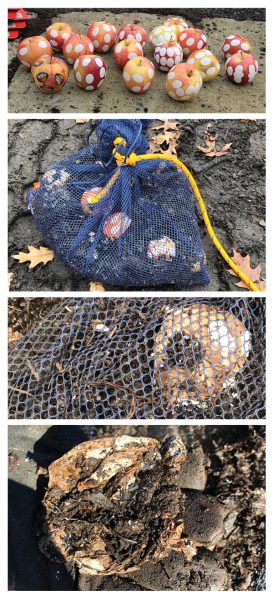
Trials for compostable produce stickers featuring a plastic film layer made from Novamont’s Mater-Bi compostable resin.
New England Compost, LLC, a medium-size aerobic static pile (ASP) composting facility in Danbury, tested the compostability of certified compostable produce stickers during the winter of 2018-2019. Novamont North America provided the stickers — which have a plastic film layer made from Novamont’s Mater-Bi compostable resin — for the trial. Polycart S.p.A. in Italy manufactures the stickers. The test protocol involved applying the stickers to apples and putting the whole and quartered apples into nondegradable mesh bags along with some food scraps and yard trimmings. The mesh bags were then buried in the active windrow (containing 80-100 cubic yards of material) so that the apples and stickers would be exposed to the microbial action of the composting process. Each mesh bag was attached to a rope and a cone marker so that it could be found when the time came to remove it from the windrow. Composting temperatures for the first half of the 30-day period were >165°F; for the second half (15 days) temperatures were >156°F.
After about 30 days of composting, the material was thoroughly mixed and formed into a new ASP for another 20 days of composting. The mesh bags were removed prior to mixing the pile, providing an opportunity to review the progress of the stickers during the composting process. “We found that most of the apples and the attached stickers had broken down into small pieces with only a few large pieces of apple remaining,” notes Jeff Demers, owner of New England Compost. After the subsequent 20 days of composting, the material was removed from the ASP and transferred to a new pile for 15 days of curing. The mesh bags were buried in the maturation pile. The compost was then screened. “At this time the contents of the mesh bags were again examined and it was found that virtually all of the stickers had disappeared,” adds Demers.
Davis, California: Compost Is Clear Carbon Storage Winner
A recent study from the University of California Davis (UC Davis) confirmed what many of us have known for our professional careers: compost makes the difference. Researchers tested soils from long-term field plots that had been established 19 years prior. They measured total soil organic carbon and nitrogen as well as bulk density (the weight of the soil per unit volume) at depths to 200 cm. By multiplying the soil bulk density and the percent carbon, you can calculate how much organic matter is stored in the soil. As increased carbon usually makes the soil lighter (decreasing bulk density), higher soil carbon concentrations do not always mean increased carbon storage. The decrease in bulk density has to be accompanied by sufficiently high increases in carbon or increases in carbon across soil depths. In the UC Davis study, the plots had been used to grow corn and tomatoes in Northern California. Treatments included fertilizer, winter cover crops and winter cover crops plus (+) chicken manure composts. While both the cover crop and cover crop + compost treatments increased soil carbon concentrations and carbon storage in the surface soils (0-30 cm), only the cover crop + compost treatment increased carbon through the entire profile. The cover crop alone treatment had decreased soil carbon storage in the 60 to 200 cm depth in comparison to the control. This does not necessarily make sense as all additions and most root growth are concentrated in the top 30 cm, but that is what the researchers found.
In comparison, the cover crop + compost treatment had higher stored carbon at depth, compared with both the cover crop and the fertilizer treatments. This treatment, the one with the compost, was the clear winner — the only one that showed increased carbon through the measured depth. No study is perfect and as we all know, only hindsight is 20:20. It would have been really helpful to have a treatment with compost alone to see if the compost would be sufficient to increase soil carbon storage. Even without that treatment, this study shows that cover crops and compost are the most effective combination for increasing soil carbon storage for the climate, soil and crop rotation tested. —Sally Brown, University of Washington
Baltimore, Maryland: Help Buy This Incredible Composting Program A Truck
The Baltimore Compost Collective (BCC) needs a new vehicle to keep employing and mentoring disadvantaged Baltimore youth. In order to grow and employ more youth to collect and compost organics, the BCC launched a fundraising campaign to purchase a truck. “A reliable vehicle is crucial to the Baltimore Compost Collective transition to a sustainable business model that can serve more customers, divert more waste and reach more youth,” notes the BCC. “By supporting this campaign, you’ll be helping us secure a new-to-us vehicle with all the associated costs (insurance, registration, maintenance, etc.).”
The BCC provides first-time employment and life skills mentorship for area youth, training participants in workforce skills and community-scale composting in the Curtis Bay neighborhood of Baltimore. Youth employees collect hundreds of pounds of food scraps each week from local customers. They convert this material into compost for use at the Filbert Street Community Garden. This project is introducing youth to the wonder of compost to enhance soil fertility, grow local food, and provide an alternative to the city’s polluting and expensive trash incinerator.
Launched in 2017 and based on BK ROT in Brooklyn, the BCC is jointly run by the Institute for Local Self-Reliance and United Workers, in partnership with Filbert Street Community Garden. Marvin Hayes, the Collective’s program manager, supervises and trains the youth workers. “We don’t just save food, we save youth,” explains Hayes. The campaign seeks to raise $20,655 by Dec. 31, 2019.
Wooster, Ohio: Turning Compost Into Car Parts
Auto industry researchers have been brainstorming ways to make car parts more affordable, durable, and eco-friendly. Among them are researchers at Ohio State University (OSU) who are testing natural auto parts made from composted materials like tomato peels and eggshells. Katrina Cornish, professor and researcher at OSU, is leading the university’s “compost to car part” project. Cornish and her team believe that tomato skins and eggshells could function as reinforcing fillers in carbon black, reports an article in Automotive News. Carbon black is a crucial component found in many rubber-based car parts, such as tires, hoses, suspension bushings, and motor mounts. Carbon black is produced by burning heavy petroleum products.
Winchendon, Massachusetts: Compost Heat Recovery
Jake and Allie Catlin purchased a dairy, on-farm cheese plant and the composting operation in Winchendon in 2017 from long-time owner Dave Smith. The dairy has an average of 160 Holsteins in the milking herd plus some dry cows. Approximately 10,200 cubic yards (cy) of manure and bedding are composted annually. The composting operation struggled with wet material, high labor inputs and not having product ready for the spring sales season. With assistance from a cost-sharing grant from the Massachusetts Clean Energy Center, and funding from the USDA Rural Development Rural Energy for America Program and the MA Department of Agricultural Resources, the Catlin Farmstead purchased a compost heat recovery system (the AGT Hot Skid 250-R) from Agrilab Technologies, Inc. (AGT). The project began in October 2018 and the system was commissioned for full operation in early June 2019.
The farm has four active composting bays. Insulated aeration lines run from the compost bays to an equipment shed where the AGT Hot Skid operates. The system sends hot water to the heated aerated drying zones. Process improvements made when the AGT unit was installed included increased fan power, larger aeration pipes, a revised composting mix for better porosity, condensation management, the two-phase aeration (active composting and drying), additional sensors to track temperature, oxygen levels, and vapor flow rates to guide the settings of operating controls, notes Brian Jerose of AGT. “Since commissioning, the biggest impact is reduction in product screening labor and costs,” he says. The composting operation has increased its screening yields by 50 percent, enabling it to meet growing demand for its product.


